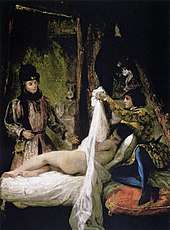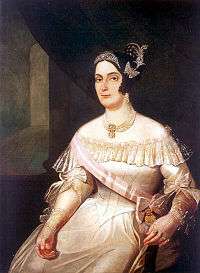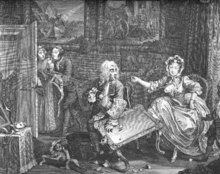Mistress (lover)
A mistress is a relatively long-term female lover and companion who is not married to her partner, especially when her partner is married to someone else.
.jpg)
Description
A mistress is in a long-term relationship with her attached lover, and is often referred to as the other woman. Generally, the relationship is stable and at least semi-permanent, but the couple does not live together openly and the relationship is usually, but not always, secret. There is often also the implication that the mistress is sometimes “kept" – i.e. that her lover is contributing to her living expenses.[1][2]
A mistress is usually not considered a prostitute: while a mistress, if "kept", may, in some sense, be exchanging sex for money, the principal difference is that a mistress has sex with fewer men and there is not so much of a direct quid pro quo between the money and the sex act. There is usually an emotional and possibly social relationship between a man and his mistress, whereas the relationship between a prostitute and their client is predominantly sexual. It is also important that the "kept" status follows the establishment of a relationship of indefinite term as opposed to the agreement on price and terms established prior to any activity with a prostitute.[3]
Historically the term has denoted a "kept woman", who was maintained in a comfortable (or even lavish) lifestyle by a wealthy man so that she would be available for his sexual pleasure. Such a woman could move between the roles of a mistress and a courtesan depending on her situation and environment.
In modern times the word "mistress" is used primarily to refer to the female lover of a man who is married to another woman; in the case of an unmarried man, it is usual to speak of a "girlfriend" or "partner".
The term "mistress" was originally used as a neutral feminine counterpart to "mister" or "master".[1]
History


The historically best known and most-researched mistresses are the royal mistresses of European monarchs, for example, Agnès Sorel, Diane de Poitiers, Barbara Villiers, Nell Gwyn and Madame de Pompadour.[4] The keeping of a mistress in Europe was not confined to royalty and nobility, but permeated down through the social ranks, essentially to any man who could afford to do so. Any man who could afford a mistress could have one (or more), regardless of social position. A wealthy merchant or a young noble might have had a kept woman. Being a mistress was typically an occupation for a younger woman who, if she were fortunate, might go on to marry her lover or another man of rank.[5]
The ballad "The Three Ravens" (published in 1611, but possibly older) extolls the loyal mistress of a slain knight, who buries her dead lover and then dies of the exertion, as she was in an advanced stage of pregnancy. The ballad-maker assigned this role to the knight's mistress ("leman" was the term common at the time) rather than to his wife.[6][7]
In the courts of Europe, particularly Versailles and Whitehall in the 17th and 18th centuries, a mistress often wielded great power and influence. A king might have numerous mistresses, but have a single "favourite mistress" or "official mistress" (in French, maîtresse en titre), as with Louis XV and Madame de Pompadour. The mistresses of both Louis XV (especially Madame de Pompadour) and Charles II were often considered to exert great influence over their lovers, the relationships being open secrets.[8] Other than wealthy merchants and kings, Alexander VI is but one example of a Pope who kept mistresses.[9] While the extremely wealthy might keep a mistress for life (as George II of England did with "Mrs Howard", even after they were no longer romantically linked), such was not the case for most kept women.[10]
In 1736, when George II was newly ascendant, Henry Fielding (in Pasquin) has his Lord Place say, "[...] but, miss, every one now keeps and is kept; there are no such things as marriages now-a-days, unless merely Smithfield contracts, and that for the support of families; but then the husband and wife both take into keeping within a fortnight".[11]
Occasionally the mistress is in a superior position both financially and socially to her lover. As a widow, Catherine the Great was known to have been involved with several successive men during her reign; but, like many powerful women of her era, in spite of being a widow free to marry, she chose not to share her power with a husband, preferring to maintain absolute power alone.[12]
In literature, D. H. Lawrence's 1928 novel Lady Chatterley's Lover portrays a situation where a woman becomes the mistress of her husband's gamekeeper.[13] Until recently, a woman's taking a socially inferior lover was considered much more shocking than the reverse situation.
20th century
During the 20th century, as many women became better educated and more able to support themselves, fewer women found satisfaction in the position of being a mistress and were more likely to be in relationships with unmarried men. As divorce became more socially acceptable, it was easier for men to divorce their wives and marry the women who, in earlier years, might have been their mistresses. The practice of having a mistress continued among some married men, especially the wealthy. Occasionally, men married their mistresses. The late Sir James Goldsmith, on marrying his mistress, Lady Annabel Birley, declared, "When you marry your mistress, you create a job vacancy".[14] One recent example of a mistress is Camilla Parker-Bowles.
Male equivalent
For male mistress, the term "mister" can be used. "Paramour" is sometimes used, but this term can apply to either partner in an illicit relationship, so it is not exclusively male. If the man is being financially supported, especially by a wealthy older woman or man, he is a kept man. The term mister-ess has been suggested.[15]
In 18th and 19th-century Italy, the terms cicisbeo and cavalier servente were used to describe a man who was the professed gallant and lover of a married woman. Another word that has been used for a male mistress is gigolo, though this carries connotations of brief duration and expectation of payment, i.e. prostitution.
In literature

In both John Cleland's 1748 novel Fanny Hill and Daniel Defoe's 1722 Moll Flanders, as well as in countless novels of feminine peril, the distinction between a "kept woman" and a prostitute is all-important.[16][17]
Apologists for the practice of mistresses referred to the practice in the ancient Near East of keeping a concubine; they frequently quoted verses from the Old Testament to show that mistress-keeping was an ancient practice that was, if not acceptable, at least understandable.[18] John Dryden, in Annus Mirabilis, suggested that the king's keeping of mistresses and production of bastards was a result of his abundance of generosity and spirit.[19] In its more sinister form, the theme of being "kept" is never far from the surface in novels about women as victims in the 18th century in England, whether in the novels of Eliza Haywood or Samuel Richardson (whose heroines in Pamela and Clarissa are both put in a position of being threatened with sexual degradation and being reduced to the status of a kept object).[20]
With the Romantics of the early 19th century, the subject of "keeping" becomes more problematic, in that a non-marital sexual union can occasionally be celebrated as a woman's free choice and a noble alternative. Maryann Evans (better known as George Eliot) defiantly lived "in sin" with a married man, partially as a sign of her independence of middle-class morality. Her independence required that she not be "kept".[21][22]
Charlotte Brontë's novel Jane Eyre (1848) presents impassioned arguments on both sides of this question, as Rochester, unable to be free of his insane wife, tries to persuade Jane Eyre to live with him, which she resists.[23]
Margaret Mitchell's novel Gone with the Wind (1936) also implies that Scarlett O'Hara should be the mistress of Rhett Butler, which was thought of as prostitution by O'Hara as she said she would be no better than Belle Watling.
See also
- Alienation of affections
- Cicisbeo
- Concubine
- English royal mistress
- French royal mistresses
- Polygyny threshold model
- Sugar baby
References
Citations
- The Free Dictionary. "Mistress". Retrieved May 6, 2012.
- Love-Lessions. "The Role of a Mistress: Is it as Glamorous as it Seems?". Retrieved May 6, 2012.
- Fulbright, Dr. Yvonne K. "FOXSexpert: Is Having a Sugar Daddy Kind of Like Being a Prostitute?". Archived from the original on April 15, 2012. Retrieved May 6, 2012.
- Derrick, Kiri. "Top 10 Philandering English Monarchs". Retrieved May 6, 2012.
- Ives, Eric. "Marrying for Love: The Experience of Edward IV and Henry VIII". Retrieved May 6, 2012.
- Palermo, Martin. "The Three Ravens". Retrieved May 6, 2012.
- Housman, John E. (1952). British Popular Ballads. Ayer Publishing. pp. 105–106.
- Herman, Eleanor (2005). Sex with Kings: 500 Years of Adultery, Power, Rivalry and Revenge. HarperCollins. p. 9.
- NNDB. "Pope Alexander VI". Retrieved May 6, 2012.
- Pope, Alexander (1871). The works: including several hundred unpublished letters, and other new materials, Volume 7. Murray. p. 106.
- Fielding, Henry (1824). The works of Henry Fielding, with a life of the author, Volume 3. Richards and Co. p. 302.
- Johnson Lewis, Jone. "Catherine the Great". Retrieved May 6, 2012.
- The Literature Network. "Lady Chatterley's Lover". Retrieved May 6, 2012.
- Rees, Nigel (ed.) Cassell Companion to Quotations (1997) ISBN 0-304-34848-1. There is some dispute about the exact wording. man is not allowed to marry his mistress_5100 Quotesmith has it as: "When a man marries his mistress it creates a job opportunity".
John Simon's obituary of Goldsmith in the National Review (September 1, 1997) says this:
Women adored him and he adored women. He married three times and had numerous mistresses. (Yet another Jimmyism: 'When you marry your mistress you create a job vacancy.') He was loyal, in his own way, to all of them, and all of them were loyal to him. He had eight children by four different women, and never have I seen a more closely knit family.
- "The Petraeus Affair: Why Is There No Male Equivalent for 'Mistress'?". Huffington Post.
- Cleland, John (1986). Fanny Hill: Or, Memoirs of a Woman of Pleasure. Penguin Classics. ISBN 0-14-043249-3.
- BookRags. "Moll Flanders | Research & Encyclopedia Articles". Retrieved May 7, 2012.
- Baker, D.L. (2009). Tight Fists Or Open Hands?: Wealth and Poverty in Old Testament Law. Wm. B. Eerdmans Publishing. pp. 151–160. ISBN 9780802862839.
- Dryden, John. "Annus Mirabilis". Retrieved May 7, 2012.
- Richardson, Samuel (1755). A collection of the moral and instructive A collection of the moral and instructive sentiments, maxims, cautions, and reflexions, contained in the histories of Pamela, Clarissa, and Sir Charles Grandison. Printed for S. Richardson; and sold by C. Hitch and L. Hawes.
- Hughes, Annika M. "Mary Ann Evans and George Eliot: One Woman" (PDF). Retrieved May 7, 2012.
- Liukkonen, Petri. "George Eliot". Books and Writers (kirjasto.sci.fi). Finland: Kuusankoski Public Library. Archived from the original on March 13, 2012.
- The Great Books Foundation. "Jane Eyre". Archived from the original on June 20, 2012. Retrieved May 7, 2012.
Sources
- Books
- Cronin, Vincent (1974). Louis and Antoinette. London: HarperCollins Publishers Limited. ISBN 0-00-211494-1.
- Mitford, Nancy (1954). Madame de Pompadour. London: Hamish Hamilton Ltd.
Further reading
- "History of a Deeply Complex Word: The Many Meanings of 'Mistress'". All Things Considered. NPR. August 22, 2015. Retrieved August 23, 2015.
- Sova, Dawn B. (2001) [1993]. The Encyclopedia of Mistresses. London: Robson Books. ISBN 1-86105-387-8. OCLC 46503143.
